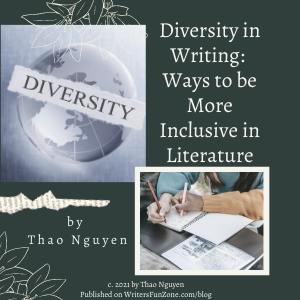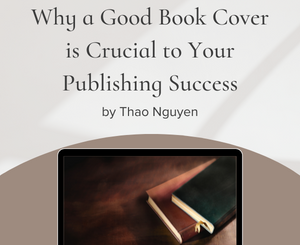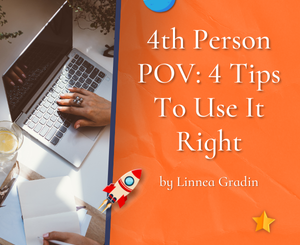Diversity in Writing: Ways to be More Inclusive in Literature by Thao Nguyen
 Today we welcome a new guest writer to Writer’s Fun Zone, Thao Nguyen who is stopping by to chat with us about “Diversity in Writing: Ways to be More Inclusive in Literature.” Enjoy!
Today we welcome a new guest writer to Writer’s Fun Zone, Thao Nguyen who is stopping by to chat with us about “Diversity in Writing: Ways to be More Inclusive in Literature.” Enjoy!
***
Diversity comes in many forms, from things that we’ve tried to categorize (like ethnicities), to things that are constantly transforming (like gender identities), to things that are just bundled together (like disabilities).
It’s no doubt difficult to approach diversity as a writer, especially when you yourself may not have experienced those circumstances or been underrepresented in those specific ways.
But what are books if not a medium through which we can better empathize with others?
Uplifting writers from underrepresented backgrounds is the most effective way to improve diversity in publishing, although that doesn’t mean you can’t try to be more inclusive with your own writing as well.
Tips to Bring Diversity to Your Writing
With that in mind, I’m here to share some tips that have helped me better appreciate and portray diversity in my writing.
1. Understand Perspective: Point of View
The first step to putting myself in the place of others is to realize I’m standing at a completely different position.
Everyone has a particular background and set of experiences that shapes their concerns and purposes, and gives them a perspective that’s not quite the same as anyone else’s.
It’s as if we’ve each been given a slightly different pair of tinted glasses to wear: in order to truly see what it’s like to look through another person’s lens, you have to remove your own first.
Being aware of this makes it a bit easier to mindfully unpack characters’ motivations and developments.
On a more tangible note, carefully considering which point of view your story is to be told through can also make a difference in the inclusivity of your writing.
Choosing to tell a story from the first person or third-person limited viewpoint, for example, allows you to delve into the inner workings of a character’s mind, and this can reveal specific emotions or thought processes very well. In such a case, the stylistic choices you make as a narrator can also portray diversity.
For instance, in the inclusive children’s book Julián is a Mermaid, told in third person limited, the use of “abuela” for grandmother adds another layer of diversity to the overarching gender-inclusive theme. A choice like this is small and sometimes only subconsciously registered by readers, but it builds a more elaborate and realistic representation of your character’s background.
2. Read Outside of Your Comfort Zone
As with voice, style, and plotting, you can learn a lot about writing diversely through reading.
If you’re writing about a particular historical event, for instance, reading nonfiction about that time period will naturally be part of your research.
Some examples:
Similarly, reading diaries and other primary sources of the people you want to represent is important work that you must do before you write. But even beyond that, reading about a variety of cultures and perceptions, in both fiction and nonfiction, can naturally expose you to more ideas and keep you thinking about diversity without having to actively remind yourself to do it.
On a more empathic level, perusing diverse books lets you slip into different worlds and minds the same way talking to people does. It might even be more useful, since you have the time to mull over details, and the author has also honed their prose or verses to deliver the strongest and most important messages.
In any case, constantly stepping out of the areas you already know to discover other perspectives is always a wonderful and enriching thing to do. And it goes without saying, but there’s no better way to support diverse authors and booksellers than purchasing and reading their titles!
3. Include Intersectional Diversity
Another good way to approach inclusivity is not to think about a character as a specific kind of character.
In other words, you shouldn’t add a diverse character for diversity’s sake.
Nobody is just Black or white or Asian or Latinx.
Nobody is just gay or straight or bisexual or transgender.
Everybody is a mixture of several aspects of identity, and the most endearing characters reflect that.
Even as you’re starting to write a story, sketch out characters that have a multitude of identities, so you can better construct moments where those parts of their identity get to shine.
Consider their ethnicity, nationality, gender identity, social class, and whether they are disabled or not.
You might find that each combination of backgrounds can create a different collection of values and concerns.
For instance, a second generation Vietnamese immigrant who’s descended from war refugees may have a very different outlook on their ancestry than a Vietnamese who’s parents have invested in their education by sending them to boarding schools abroad. Understanding and appreciating this intersectionality asks you to be a dedicated writer who’s ready to dive into various research projects, but all of it pays off when your writing becomes inclusive without falling prey to typecasting.
4. Find an Appropriate Beta Reader or Editor
And finally, a manuscript is never finished without feedback and revision.
When you’re setting out to be more diverse, and you’ve featured experiences that you didn’t directly live through, then having an appropriate beta reader (possibly a sensitivity reader), or an editor who knows how to approach such subjects, is crucial.
They can point out anything that’s incorrect or might not sit well with readers from that background.
After all, no matter what aspects of diversity you choose to tackle, you are providing a representation for a lot of people — it can’t be easy, and some oversight is definitely a good thing.
Ideally, you want to work with a reader or editor who has worked with diverse writing before.
Of course, being from the relevant backgrounds themselves is helpful as well.
Where to Find Such Editors
There are plenty of places to find such editors — Reedsy has a broad range of race-related categories to identify your manuscript as you’re narrowing down the search for the right professional editor.
Twitter’s also a good starting point: following accounts like Conscious Style Guide can lead you to many diverse editors who are always happy to help.
Diversity in Writing: Not Easy but Necessary
Writing about diversity is not easy, and the most impactful stories will have to be told by those who actually live with the stories they tell.
But that shouldn’t stop you from opening the doors of your own writing to more inclusive tales — and hopefully, with these tips, you’ll find doing this a little bit easier.
***
ABOUT THE AUTHOR
 Thao Nguyen writes about history, diasporic experiences, and writing. You can find her work in Literally Stories, Anak Sastra, or on Twitter @thao__to
Thao Nguyen writes about history, diasporic experiences, and writing. You can find her work in Literally Stories, Anak Sastra, or on Twitter @thao__to
***
Editor’s Note: Resources for developing your story and your characters so that you have diversity in your writing:
- Plan Your Novel course: https://school.bethbarany.com/p/30daywc
- Craft Compelling Characters: http://school.bethbarany.com/courses/enrolled/compelling-characters






